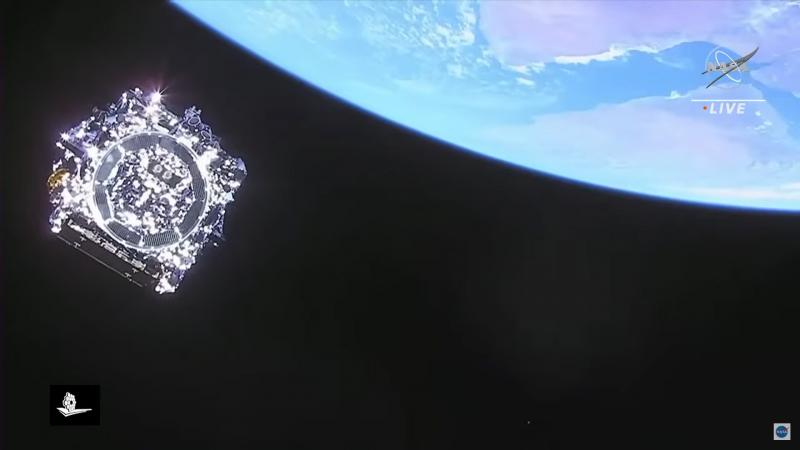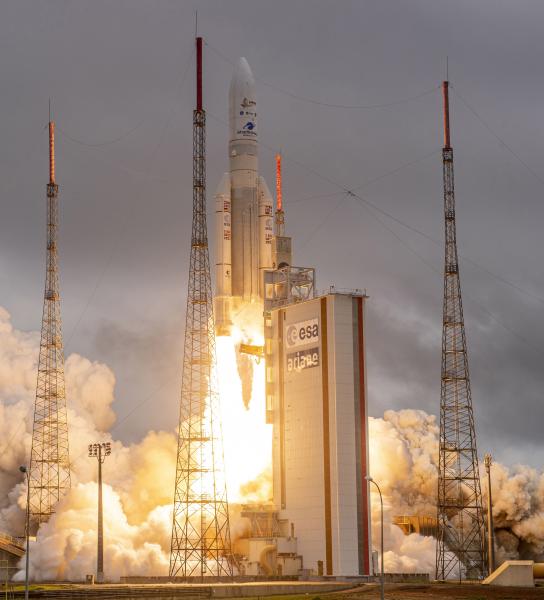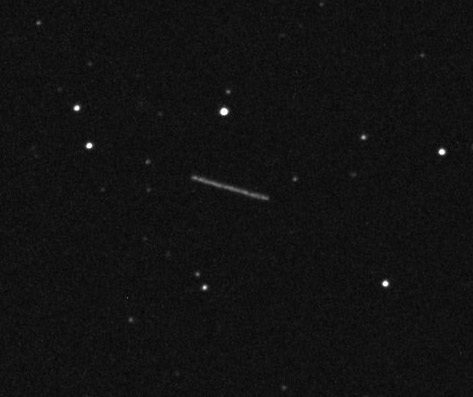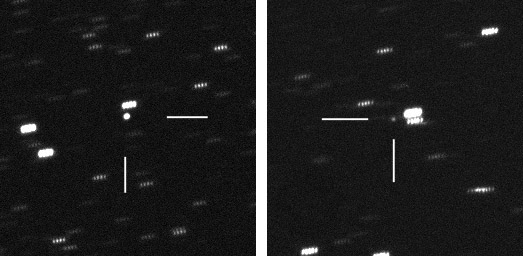Imaging the James Webb Space Telescope on its way to L2
2022 January 29

Finally, at 12:20 UTC on Christmas Day, the James Webb Space Telescope (JWST) left the Earth atop an Ariane 5 ECA launch vehicle. Thirty seconds after launch it disappeared into thick clouds above the French Guiana launch site, but the Ariane core stage and solid boosters performed perfectly until shutdown and separation at T+ 8m 47s. After separation, JWST was propelled by the five-metre-long Ariane ESC-A upper stage for a further 16 minutes. This placed it on the required transfer trajectory towards its final destination: a halo orbit around the L2 Lagrange point, 1.5 million kilometres from Earth.

The JWST Optical Telescope Element (OTE) is a 6.5m, ƒ/20, Korsch three-mirror anastigmat. This consists of an ellipsoidal primary, made up of 18 hexagonal, gold-plated, beryllium segments, a 0.74m hyperbolic secondary and a small ellipsoidal tertiary. The telescope and its instruments are designed to operate at red to infrared wavelengths (λ = 0.6 to 28 micrometres). Since it is observing in the infrared, the telescope must be cold. To ensure a long mission lifetime, it is passively cooled by a 21×14m, five-layer, aluminium-coated Kapton sunshield.
All the complex elements of the observatory had to be folded up to fit within the Ariane fairing; they would then be deployed during the journey to L2. The first critical deployment was the solar array and the Ariane injection attitude was so good that this occurred earlier than expected, while the spacecraft was still visible in the upper-stage forward-camera video feed. At the time of writing (2022 Jan 3), all the other deployments, including that of the sunshield, have gone well.
We have been able to image JWST as it moves away from Earth, since it was conveniently situated in Orion. The first image submitted was obtained by Denis Buczynski, at 21:56 UTC on the night of the launch. At that time the spacecraft had a high apparent motion and so it appears in the photograph as a streak moving relative to the background stars. Later images were submitted by Peter Carson, David Swan, George Carey, Dave Eagle, Tim Haymes and me. On 2022 Jan 2, with the sunshield fully deployed but not yet tensioned, JWST was magnitude 14.5 at a range of 800,000km. This implies that it will be around magnitude 16 at L2 (although this will strongly depend on the solar aspect angle). That should make it a relatively easy imaging target.


The upper stage performed a final burn after telescope separation, to ensure that it would not collide with the spacecraft. While JWST itself is precisely tracked by radio, the upper stage is passive and so astrometry is useful to determine where it will end up. As of 2022 Jan 2, the upper stage was magnitude 17.4 at a range of 890,000km. I have used astrometry from Peter Carson, Denis Buczynski, Patrick Wiggins and myself to determine its future trajectory with Bill Gray’s FindOrb program. It will enter a heliocentric orbit, with a period of just over 380 days, and will fade below magnitude 20 in early 2022 February. The stage will return to Earth’s vicinity in the summer of 2047, reaching magnitude 20 for a short time.
Nick James, Director, BAA Comet Section
| The British Astronomical Association supports amateur astronomers around the UK and the rest of the world. Find out more about the BAA or join us. |
